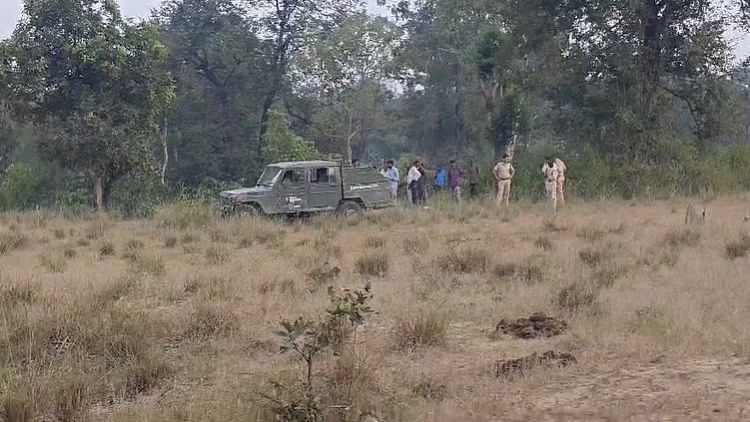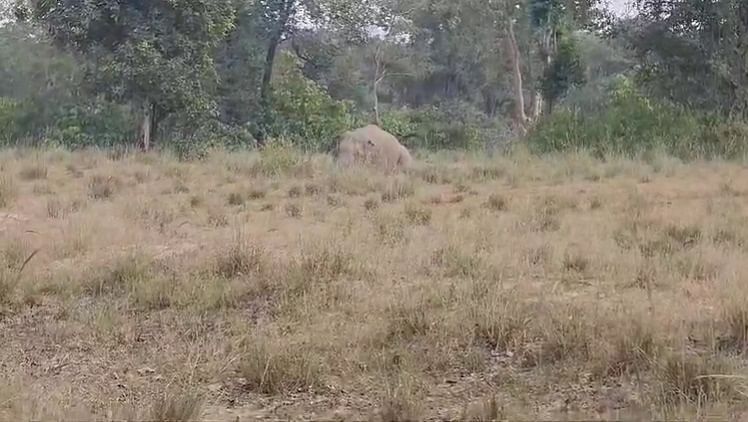Bhopal: A three-member team of top forest officials formed by Madhya Pradesh Chief Minister Mohan Yadav, which ruled out any ‘conspiracy’ to kill the 10 Bandhavgarh elephants, carried out a day-long investigation Saturday to ascertain the events leading up to the tuskers’ deaths.
The team included Minister of State for Forest and Environment Dilip Ahirwar, along with Additional Chief Secretary (ACS, Forest) Ashok Barnwal, and the state’s head of forest force (HOFF) Aseem Shrivastava.
On Saturday, they walked the trails taken by the elephants, inspected the fields of four farmers where the pachyderms are suspected to have grazed on Kodo millet, spoke to forest guards who first heard the cries of the elephants writhing in pain while lying in the fields, and also questioned the farmers. After their day-long mission, the team ruled out any attempt of deliberate poisoning. The environment ministry, however, has not yet ruled out foul play as a result of human-animal conflict, as it awaits formal reports from the MP government and the Wildlife Crime Control Bureau (WCCB).

Significantly, according to a senior Madhya Pradesh government official aware of the findings, the team also got to know that the elephants allegedly consumed standing Kodo millet crops, contrary to the earlier theory that the tuskers may have grazed on harvested crops that had gathered fungus lying for days by the fields. That the elephants consumed standing crops further indicated that there was no apparent conspiracy, the official said.
Speaking to ThePrint, HOFF Aseem Shrivastava, who was part of the team, told ThePrint: “It is only the lab reports that can conclusively show what the toxins are. We have sent all the samples for investigation. There was no indication of deliberate poisoning on the fields.”
He added: “What truly happened after they ate kodo and drank the water from the stream and how did it turn toxic will be determined after detailed reports are available. But prima facie, there seems to be no deliberate attempt at poisoning these elephants.”
At around 2 am on 29 October, the herd of 13 Bandhavgarh elephants reached Salkhaniya village — 40 kilometres away from the tiger reserve. They damaged the crops, eating Kodo millet yet to be harvested. According to a senior official of the forest department, the elephants had come to Salkaniya after a span of two to three years, so the farmers never expected they would come and consume their crop.
“The elephants ate from the fields of four farmers. Among them, one farmer had harvested the crop and kept it in the corner of his field. But that bundle of harvested crop was not touched by the elephants. Instead, they had grazed on the standing crops before the farmer shooed them away,” said the senior official. Samples were collected from this bundle.
The elephants then walked a kilometre and drank from a stream nearby. “While it is a stream of running water, there were certain places where the water had accumulated but there were absolutely no signs of contamination or poisoning in the stream as there were other animals like monkeys that drank the water and it had no impact,” said the official.
‘One vet at Bandhavgarh, 9 more vets brought in’
According to forest officials, it was after the elephants consumed the Kodo millet and drank from the stream, that they started falling ill, having moved around 200 metres away from the water body. A reaction seemed to have been triggered an hour after the elephants consumed the Kodo and drank the water, they said, adding that this happened between 3 am and 4 am.
The elephants then started collapsing and wailing in pain. At around 10 am, villagers began to alert the forest guards, who in turn informed the forest department. The point where the elephants collapsed, located within a core area, takes about an hour to reach from Bandhavgarh.
With Bandhavgarh having just one veterinarian, more vets were called in. “The veterinarian from Bandhavgarh consulted other vets. Soon the district veterinarians from Umaria and Katni were called in along with vets from Sanjay Dubri tiger reserve and School of Wildlife Forensic and Health (SWFM) in Jabalpur,” the forest official, quoted earlier, added.
The nine vets reached the spot around 12.30 pm and started treatment. “While the team was trying to do its best, as the sun began to set (later), it made the whole process for the veterinary team even more difficult,” the official quoted earlier, added. The veterinary team also called in a JCB which was used to make the elephants lie on the ground, or stand on their feet, but it did not work.
What made matters more difficult, the government official said, was that while some of the elephants were incapacitated, others that were still able to move, began to get aggressive as the forest officials tried to approach them.

Soon the elephants began to succumb to multiple organ failure, one after another. The post-mortem subsequently revealed large amounts of kodo millets in their stomachs. “It also indicated excessive haemorrhaging, which indicated that the vets could have hardly done anything to save these elephants,” another senior official added.
The officials are also looking at earlier recorded instances of elephant deaths after consuming Kodo millet. In one such instance recorded in 1933 in Tamil Nadu, 14 elephants had died on 17 December 1933 after consuming Kodo, locally known as ‘Varagu’.
(Edited by Gitanjali Das)
Also Read: 2 men killed, 1 injured by elephant near Bandhavgarh, days after 10 tuskers’ deaths at tiger reserve






